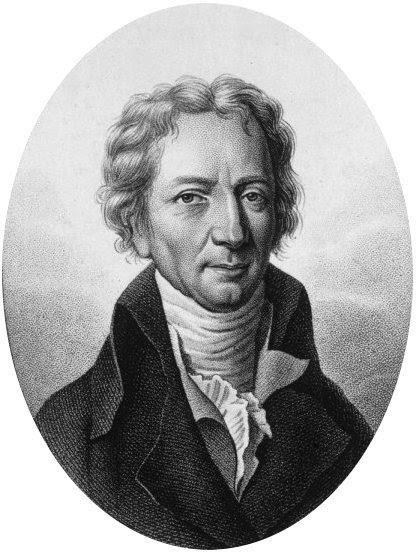
Déodat de Dolomieu (1750 – 1801)
On June 23, 1750, French geologist Déodat Gratet de Dolomieu was born. He is best known for his field research in mineralogy. The mineral and the rock dolomite and the largest summital crater on the Piton de la Fournaise volcano were named after him.
Déodat de Dolomieu, a Non-Actualistic Catastrophist
Déodat de Dolomieu grew up in the Alps of southeastern France and showed early interest in his surrounding nature. However, he started a military career when he was only 12 years old and even fought a duel, killing a fellow member of the Maltese Order in later years. Soon, the young Dolomieu became known as highly attracted to women, especially among the nobility. He was made a corresponding member of the Royal Academy of Sciences and played a significant role in the intellectual progress of France. De Dolomieu spent much of his time collecting minerals and visiting mining areas and categorizing geological data across Europe. He had a great interest in volcanoes, but was soon convinced, that water played a major role in shaping the surface of the Earth through a series of prehistoric, catastrophic events.
His particular interests included mineralogy, volcanology, and the origin of mountain ranges. Although De Dolomieu was greatly interested in volcanoes, he became convinced that water played a major role in shaping the surface of the Earth through a series of prehistoric, catastrophic events. De Dolomieu was not a uniformitarian geologist. He has been described as a “non-actualistic catastrophist”. His contemporary, James Hutton, did not publish the principle of uniformitarianism until 1795.[4] De Dolomieu was an observationalist and spent much of his time collecting and categorizing geological data. Unlike Hutton, no scientific principles or theories are credited to him, although he left his permanent mark on geology in another way: that is by discovering the mineral dolomite that would be named after him.
Dolomite
During one of his voyages to the Alps of Tyrol, De Dolomieu discovered a calcareous rock which, unlike limestone, did not effervesce with weak hydrochloric acid. The geologist published his findings in the French science magazine “Journal de Physique” in 1791 and one year later, the rock was given the name dolomite by the Swiss chemist Nicolas-Théodore de Saussure. Still, De Dolomieu was not the first to describe the mineral, earlier descriptions came from Linnaeus, who was the first to note the fact that this rock resembled limestone but does not effervesce with dilute acid.[3] In the meantime, Dolomieu advanced in rank in the Knights of Malta and was promoted to Commander in 1780. In the same year, he retired from active military service, partly due to the fact that his liberal political leanings which were unpopular among the conservative nobility, ruling the Order. From then on, De Dolomieu devoted all his life to science and traveling.
École Nationale Supérieure des Mines de Paris
Around 1795, De Dolomieu accepted the position of Professor of Natural Sciences at the École Centrale Paris and started to write the mineralogical section of the Encyclopédie Méthodique. In the following year, he was appointed Inspector of Mines and Professor at the École Nationale Supérieure des Mines de Paris, where his portrait is still displayed in the library. His extensive mineral collection is today housed at the Muséum National d’Histoire Naturelle of Paris. Only three years after his career as professor started, De Dolomieu had developed a great international reputation and he was considered as one of the most important geologists of his time.
Dolomieu and Napoleon Bonaparte
Dolomieu should have a restless end of life. He participated in the Egyptian campaign of Napoleon Bonaparte, whom he had supported since revolutionary times. On the way there, Bonaparte stopped in Malta to seize it. It was Dolomieu, knight of St. John of Jerusalem, who was charged, in spite of Napoleon himself, to negotiate its surrender. After some scientific work on the Nile, Dolomieu requested his return to France out of disagreement with Bonaparte. However, on his way back home he was captured in Calabria and imprisoned in Sicily for 21 months for obscure reasons of political conflicts with the order of Saint John of Jerusalem. He only regained his freedom on 14 June 1800 after the victory of the French armies at Marengo (he was one of the prisoners freed by the Treaty of Florence). Badly affected by this imprisonment, he died on November 28, 1801 (the 7th of the year X), in Châteauneuf (Saône-et-Loire), at the home of his sister, Marquise de Drée.
Besides others, the mineral dolomite and the dolomite stone were named after him.
Shridar Anandakrishnan, GEOSC 10 Unit 10 Lecture: Deep Time, Uniformitarianism & the Age of the Earth, [6]
References and Further Reading:
- [1] De Dolomieu at the German National Library
- [2] Der Namensgeber der Dolomiten – Der Forschungsreisende Déodat de Dolomieu (1750–1801)
- [3] Carl Linnaeus – ‘Princeps Botanicorum’, the Prince of Botany, SciHi Blog
- [4] James Hutton – the Father of Modern Geology, SciHi Blog
- [5] Deodat de Dolomieu at Wikidata
- [6] GEOSC 10 Unit 10 Lecture: Deep Time, Uniformitarianism & the Age of the Earth, Dutton Institute @ youtube
- [7] Hooykaas, R. (1970). Catastrophism in Geology: Its Scientific Character in Relation to Actualism and Uniformitarianism. Koninklijke Nederlandse Akademie van Wetenschappen, Afdeling Letterkunde, 33 (7): 271-316.
- [8] Charles-Vallin, T. (2003). Les aventures du chevalier géologue Déodat de Dolomieu. Presses Universitaires de Grenoble, Grenoble.
- [9] Timeline of French Geologists via DBpedia and Wikidata





